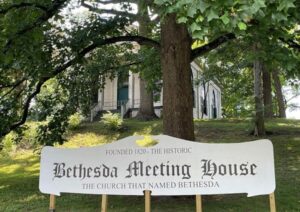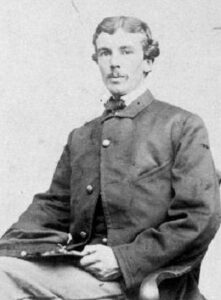Homepage edit Aug 28
Bethesda Historical Society's Celebration
of the 40th Anniversary of the opening of the
Bethesda Metro Station

Watch Bethesda Historical Society’s Hank Levine discuss the historical significance of Metrorail’s arrival in Bethesda in August 1984 here on NBC Washington’s Channel 4.
Shade, Lemonade and History
at the Bethesda Meeting House September 8

Please join us Sunday September 8th from 1:00 pm to 4:00 pm to beat the heat at the historic Bethesda Meeting House (9400 Rockville Pike, accessible only when driving south towards NIH.)
Relax beneath old shade trees and sip some lemonade with other Bethesda history lovers. You’ll have the opportunity to tour the site and learn more about it. You are also welcome to bring your gloves, tools and your energy if you’d like to help us garden. We are looking forward to seeing you. No need to RSVP. Ample parking is available.
A Civil War skirmish in downtown Bethesda 160 Years Ago This Summer
In 1864, Bethesda was not much more than a stop on the way to somewhere else. But on July 11th of that year, what is now downtown Bethesda was the site of a skirmish between Union and Confederate forces that proved important in defending the nation’s capital from a Confederate assault.

On that morning, after advancing from Rockville to the Bethesda Meeting House site just north of today’s National Institutes of Health, 27-year-old Confederate General John McCausland and his 800 troops headed south on Rockville Pike towards the Union Army’s Fort Reno, located near today’s Tenleytown in the District of Columbia.
But at the vicinity of the Old Stone Tavern, where today’s Pumphrey’s Funeral now sits in downtown Bethesda, they were stopped by 600 Union forces dispatched from Tenleytown under the command of 29-year-old Colonel Charles Russell Lowell.

What followed was a skirmish with only slight casualties that lasted until mid-afternoon. It seems likely that the front line moved back and forth through the village as the day wore on, but the Confederates never advanced any further south than Bethesda on the Rockville Pike.
So although the engagement was a tactical draw, it was a strategic victory for the defending Union forces, like the more substantial engagement a few miles east at Fort Stevens just west of what is today Georgia Avenue.
“The Battle of Bethesda: A daylong firefight in Jubal Early’s march into Washington” by John H. Walsh (Washington Post April 26, 2014)
Past, Present and Future of the
Bethesda Meeting House

Watch Hank Levine, president of the Bethesda Meeting House Foundation, present an illustrated tour of this iconic building’s history, architecture and significance.
Click here to watch it on Youtube.
Hank’s presentation begins at the 3:10 mark.
Contact us at bethesdahistory@gmail.com
We bought the Bethesda Meeting House!

Bethesda Meeting House Bought by Local Historic Preservation Group
Bethesda, MD January 8, 2024–The Bethesda Historical Society today announced the purchase of the historic Bethesda Meeting House, “the church that named Bethesda.”
A new entity, the Bethesda Meeting House Foundation (BMHF), was formed to take ownership of the property and oversee the restoration and future use of the church and adjacent parsonage that occupy it.
The Meeting House and parsonage sit on a hill overlooking Rockville Pike just north of the National Institutes of Health campus. The first Meeting House on the site was built in 1820 by the Bethesda Presbyterian Church and named after a healing pool in Jerusalem. After fire destroyed the building in 1849, the present Meeting House was constructed, and the parsonage added.
Hank Levine, President of BMHF, noted that “the Meeting House is by far the most important historic building near downtown Bethesda and literally embodies the history of the community.” It served as the town’s first post office in 1852 and was occupied by Confederate cavalry during a July 1864 Civil War skirmish in what is now downtown Bethesda. According to legend, the Church’s bell is linked to Paul Revere and Abraham Lincoln is said to have worshipped or spoken there. The building is notable for its rare “slave gallery,” where enslaved persons were permitted to worship. The Meeting House and parsonage are listed in the National Register of Historic Places and were among the original sites on the 1979 Montgomery County Master Plan for Historic Preservation.
Wendy Kaufman, Secretary-Treasurer of BMHF, noted that “in 1871, the Church’s pastor persuaded a newly appointed local postmaster to petition the Post Office Department to rename the area Bethesda (it was then known as Darcy’s Store). The petition was granted, and the rest is – literally — history.”
The last congregation to occupy the Meeting House, Temple Hill Baptist Church, ceased worshipping there several years ago. The buildings have not been maintained, and extensive restoration work will be necessary. Leading members of the local real estate, legal, and historic preservation communities have volunteered their time and expertise to help BMHF complete the acquisition and plan the buildings’ restoration.
The Foundation is exploring the possibility of partnering with a local nonprofit organization to use the site. “It’s a community treasure,” added BMHF Vice President David Schardt, “and it deserves to be a civic asset.”

Support the Bethesda Meeting House Foundation!
The Bethesda Meeting House Foundation is raising funds through Garden for Wildlife native plant sales. This is a “feel good, do good” fundraiser that helps our organization not only earn much needed financial resources but it also helps our community!
The Bethesda Meeting House will earn 15 percent of all plant sales when you use our unique sales link:
We're always interested in Bethesda memorabilia
Do you have a copy of a history or reminiscences about your Bethesda neighborhood or your street?
 Do you collect historical artifacts of Bethesda life that you’d like to share with the community? Do you have videos of past Bethesda?
Do you collect historical artifacts of Bethesda life that you’d like to share with the community? Do you have videos of past Bethesda?
The Bethesda Historical Society would like to talk with you!
Email us at bethesdahistory@gmail.com
Bethesda Historical Society's Celebration
of the 40th Anniversary of the opening of the
Bethesda Metro Station

Watch the Bethesda Historical Society’s Hank Levine discuss the historical significance of Metrorail’s arrival in Bethesda in August 1984 here on NBC Washington’s Channel 4. (Unmute to listen.)